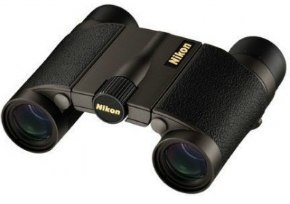
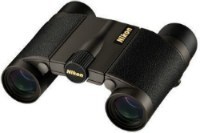 If you’re new to the world of binoculars and you’re looking into purchasing your own pair, it’s important to get all the information on a wide variety of products.
If you’re new to the world of binoculars and you’re looking into purchasing your own pair, it’s important to get all the information on a wide variety of products.
If you really want to find the best pair of binoculars for your needs, there are a variety of terms and approaches that you should look at- and these basic features help you decide whether the binoculars that you’re looking at are perfect for your particular needs.
Click here for more reviews of Nikon Premier LX-L Binoculars
The Premier LX Nikon binoculars are unique because they fit a wide variety of uses.
Typically, a pair of binoculars that have 8 x 20 magnification are more suited for theater and stadium use, but they have superior optics and weather protection to go where you do.
This makes them perfect for bird watching and field scoping wildlife or anything at a great distance.
Rated at over 1,000 yards, you’ll get close-range focuses too to see anything and everything you want.
The range of vision is also wide enough to bring you all the action, right when you need it, making them great for catching all the action. Plus, they’re compact, and perfect to pack or take with you on a trip.
Nikon Premier LX-L Specifications
| Nikon Premier LX-L 8x20 | Nikon Premier LX-L 10x25 |
|---|---|
Size8x20 | Size10x25 |
Eye Relief15 mm | Eye Relief15 mm |
Field of View356 ft/1000 yds | Field of View283 ft/1000 yds |
Close Focus8 ft | Close Focus10.4 ft |
LensesEco-Glass | LensesEco-Glass |
Weight9.5 oz | Weight10.5 oz |
Dimensions4.3 x 3.7 inches | Dimensions4.4 x 4.3 inches |
| READ REVIEWS | READ REVIEWS |
Familiarize Yourself With Compact Binoculars
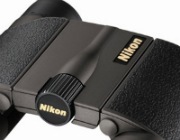 These binoculars are compact binoculars which means they come with roof prisms and a much smaller objective lens size.
These binoculars are compact binoculars which means they come with roof prisms and a much smaller objective lens size.
Basically, the larger the magnification is compared to the objective lens, the darker the image will be. So, an 8×42 will have a brighter image than a 10×42. Similarly, an 8×20 will have a darker image than an 8×42
But, what you lose in the image you gain in compactness. There is a benefit to being able to hold a pair of binoculars in the palm of your hands. The Nikon Premier LX are no different, small and compact with a good image, these won’t disappoint.
But, these will need to be used more in a brighter environment than traditional binoculars.
High Field Of View & High-Quality Lenses
 Higher fields of view let you catch more action- and better lenses give you better picture and quality.
Higher fields of view let you catch more action- and better lenses give you better picture and quality.
Not all lenses are created equal- there are two basic types of lenses Porro prism and roof prism.
Generally, Porro prism binoculars are less expensive and give a brighter image so the best quality and give you better bang for your buck. Roof prisms are more compact because the eyepiece and the objective lens can stay in alignment. But, the prisms require a special coating to keep the light in phase.
The Nikon Premier LX binoculars boast a fully multi-coated lens and phase adjusted roof prisms that allow for its ultra-compact design.
Superior Lenses
One of the best features of these particular binoculars is that the lenses are of extremely high quality.
The Nikon Premier LX have high-grade roof prisms (to ensure quality and reliability) that have been coated twice- once in silver to boost the transmission of light, and again with Nikon’s own special coating to increase the sharpness and clarity of the image you’re trying to view.
Better yet, the lenses are made to be Eco-friendly and contain no arsenic or lead in the optical system.
At this low price, you really can’t match the quality that Nikon provides because these binoculars provide the highest quality range of sight for practically anything you need them for.
Magnification of the Nikon Premier Package
These lenses are classified as 8 x 20 lenses, which means that they view images eight times the size they would be at the same distance to the human eye and they take light in with a 20mm objective lens
People who are amateurs to the world of binoculars automatically assume that higher magnifications are better, but they aren’t.
This is because it’s harder to use higher magnifications accurately and efficiently because even the slightest movement jars the image completely out of your vision.
The 20mm objective lens on these Nikons is in line with other compact binoculars. Most compact binos have a 20mm or 25mm objective lens. Remember smaller lens means less light which means not as bright of an image.
Additionally, they’re fog proof and completely moisture resistant.

Image Quality
The Nikon Premier LX combo was specially designed to deliver the brightest, clearest images you can get for a great price.
Because they’re coated in highly reflective prism coating, you’ll get the highest range and color reproducibility out there, to enhance the image. So, Nikon can give a smaller objective lens but still give a similar quality image by using prisms that reflect mroe light.
They’re great for viewing a quick, sharp image, and the lenses are coated with silver to boost the crispness of the image with enhanced reflectiveness.
Eye Relief
People who wear glasses are going to love these Nikon Binoculars.
The eye relief is satisfactory 15 millimeters, so you won’t have to take off your glasses to view these. That’s perfect for people who absolutely need their glasses to correct their vision.
They also offer high usability because the eye cuffs are built in a way that doesn’t restrict motion or catch on eyeglasses.
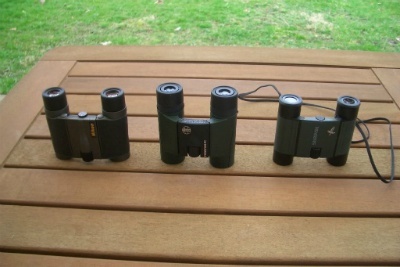
Pros of the Nikon Premier LX Combo
Cons of the Nikon Premier LX
The Wrap Up
If you want a durable, lightweight and highly versatile pair of binoculars at a reasonable price, look no further than the Nikon Premier LX combo.
Comfortable and easy to use, with a great field of vision and powerful magnification, you’ll scarcely find binoculars that meet the same needs for virtually anything.
From the theater and sporting events to hunting or birding binoculars, they provide clear, crisp images with excellent distance and quality mechanics that you’ll be glad you owned.
Review of The Nikon Premier LX Binoculars
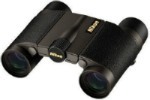
Other Reviews of The Nikon Premier Binoculars
There are a lot other binos for a way less money. But, the quality of these Nikon Premiers are over at a different level.
I was at a concert using these and a friend was using a cheaper brand. There was no comparison. The LX-L Nikon image quality made the other binoculars seem like a toy.
It took me a bit to learn out how to adjust the width to fit my eyes but after that everything worked as expected.
I've owned two Premier line Nikons and 3 NIkons overall.
The 8x32 midsize are superb optically, comparing favorably to the German's Binoculars at half the price, though it is a little bit heavy. I wanted a better pair of pocket binoculars for a while, and these rise to the occasion. These binoculars are definitely comparable to Zeiss and Leitz, and close to Swarovski (IMHO) for center and edge sharpness, brightness and lack of color fringing - and way less expensive! Some pincushion distortion, but that's normal and not a big deal.
You have to adjust the focus with the little or ring finger, and that takes a little while to get used to. It's also a little stiff below freezing temperatures, though it might get a little smoother with some more use. The off-center fold feels awkward, but a fair exchange for the good mechanisms and tiny folded size. It has an unusual diopter adjuster which I like. Extendable eyecups are very smooth. The hinges feel a little weak, but I won't know until some time passes.
The included case, with magnetic clasp, is well-made, though I would prefer Velcro clasp rather than having to thread belt through the loop.
The only thing I really don't like is the objective lens caps (eyepiece caps are included). These are marketed as pocket binoculars and most pockets aren't that friendly to glass objects. I brought this to Amazon's attention, pointing out that their ad doesn't specify caps but Nikon's site does say that the accessories include lens caps, so it implies all 4 are included. When I called Nikon, they said that they don't even make front caps for their compact binoculars. This is really weird to me because it seems like they are risking the lenses of an amazing product to save 20 or 30 cents on something that costs $400.
I bought these so I could travel with them and at first I was fairly impressed. They had a lot more contrast than my cheap Minolta 8x25's and more resistance to flare and had great detail rendition. I was fairly puzzled because the required diopter adjustment was quite significant unlike any of my other binoculars.
However, after some use I've found some problems:
- The adjustment of the diopter was not constant and I needed to correct it all the time. It turned out that the correction was depending on something that happened to be loose on the inside. I could honestly hear it rattling when I shook the binoculars. So it was impossible for the adjustment to hold steady.
- Something is wrong with contrast. I compared these Nikon with Bushnell 7x26 and it seems that the smaller details are rendered with higher contrast than larger objects. The small details contrast is similar in both binoculars, but large details look different. I looked at leaves from 20 meters and the 7x26 cuts them against the sky why the Nikon Premier made them much duller. As a result, the image looks unnatural from the Nikon. It's so much so that even view through that cheap Minolta 8x25 feels better.
- Weak mechanics. The Nikons are made from metal, but a small bump while in the case was enough to make the right hinge weak, snow now the binoculars fold down when using them.
- The warranty. Naturally, I wanted to fix the problem number 1 and sent the binoculars to California. Good news: the warranty is valid wherever you are in the world, at least if return address is in US. Bad news: they have fixed loose hinge and corrected the diopter compensation offset somewhat but have not fixed the inconsistency from the number 1 and still something is rattling inside.
So here is the risk - even if your binoculars do not have this number 1 problem from the beginning, it may develop over time and it is not covered by the warranty.
I bought the Nikon Premier 10 X 25 a while back and have been very impressed with the quality build and good image. I also have a Leica 10 x 25 Trinovid and the two are very comparable in view and image quality. The Nikon takes a little getting used to the position of the focus knob because it is near the front instead of the rear like other binoculars. I have a Leica so it's a little redundant to have these as well, but the Nikon is definitely a keeper because of the sharp image and great quality build.
Download My FULL Excel Sheet with over 200 Binoculars
I’ve compiled an Excel spreadsheet with all the binoculars that Amazon stock. I’m happy to share it with you. As it’s Excel you can slice and dice the data however you choose.
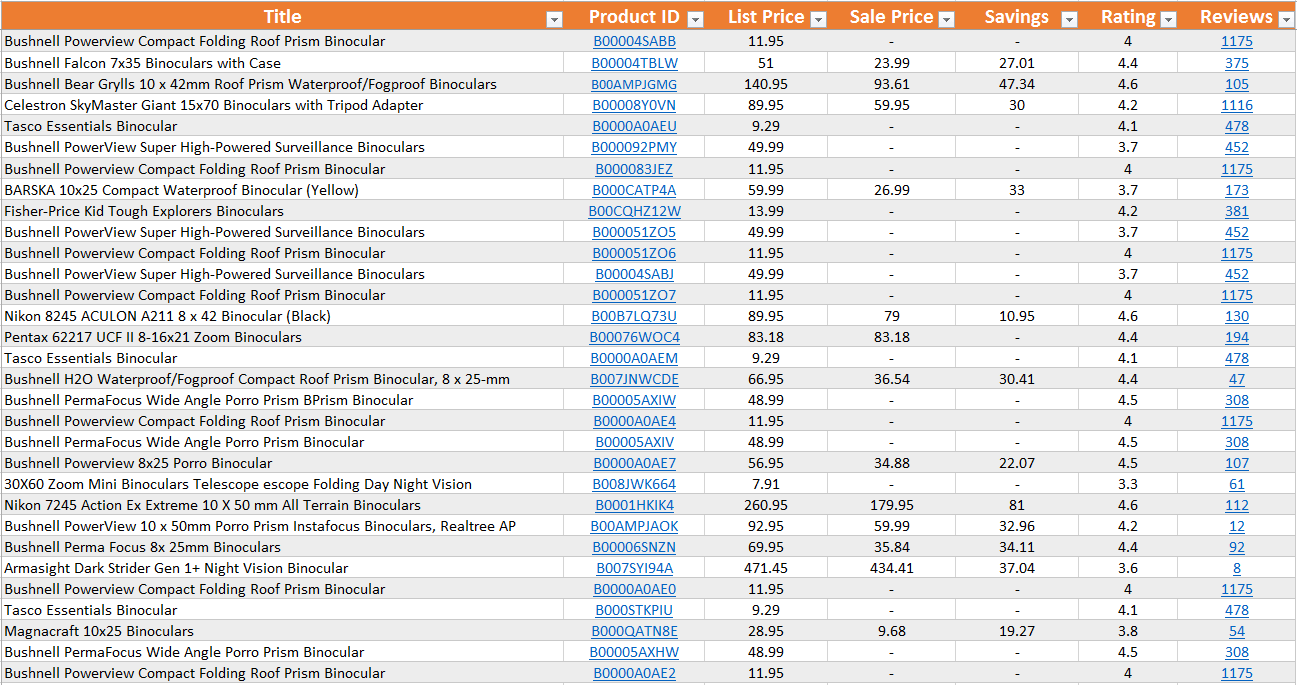
Click HERE to download the Excel file.



